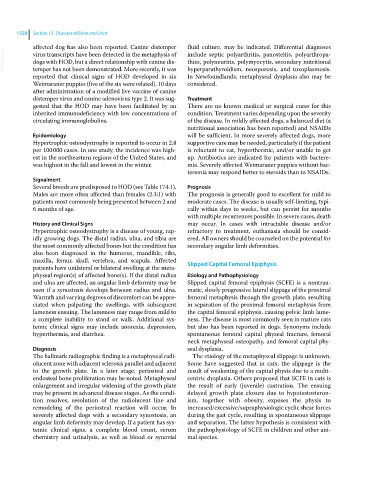Page 1612 - Clinical Small Animal Internal Medicine
P. 1612
1550 Section 13 Diseases of Bone and Joint
affected dog has also been reported. Canine distemper fluid culture, may be indicated. Differential diagnoses
VetBooks.ir virus transcripts have been detected in the metaphysis of include septic polyarthritis, panosteitis, polyarthropa-
thies, polyneuritis, polymyocytis, secondary nutritional
dogs with HOD, but a direct relationship with canine dis-
temper has not been demonstrated. More recently, it was
In Newfoundlands, metaphyseal dysplasia also may be
reported that clinical signs of HOD developed in six hyperparathyroidism, neosporosis, and toxoplasmosis.
Weimaraner puppies (five of the six were related), 10 days considered.
after administration of a modified live vaccine of canine
distemper virus and canine adenovirus type 2. It was sug- Treatment
gested that the HOD may have been facilitated by an There are no known medical or surgical cures for this
inherited immunodeficiency with low concentrations of condition. Treatment varies depending upon the severity
circulating immunoglobulins. of the disease. In mildly affected dogs, a balanced diet (a
nutritional association has been reported) and NSAIDs
Epidemiology will be sufficient. In more severely affected dogs, more
Hypertrophic osteodystrophy is reported to occur in 2.8 supportive care may be needed, particularly if the patient
per 100 000 cases. In one study, the incidence was high- is reluctant to eat, hyperthermic, and/or unable to get
est in the northeastern regions of the United States, and up. Antibiotics are indicated for patients with bactere-
was highest in the fall and lowest in the winter. mia. Severely affected Weimaraner puppies without bac-
teremia may respond better to steroids than to NSAIDs.
Signalment
Several breeds are predisposed to HOD (see Table 174.1). Prognosis
Males are more often affected than females (2.3:1) with The prognosis is generally good to excellent for mild to
patients most commonly being presented between 2 and moderate cases. The disease is usually self‐limiting, typi-
6 months of age. cally within days to weeks, but can persist for months
with multiple recurrences possible. In severe cases, death
History and Clinical Signs may occur. In cases with intractable disease and/or
Hypertrophic osteodystrophy is a disease of young, rap- refractory to treatment, euthanasia should be consid-
idly growing dogs. The distal radius, ulna, and tibia are ered. All owners should be counseled on the potential for
the most commonly affected bones but the condition has secondary angular limb deformities.
also been diagnosed in the humerus, mandible, ribs,
maxilla, femur, skull, vertebra, and scapula. Affected Slipped Capital Femoral Epiphysis
patients have unilateral or bilateral swelling at the meta-
physeal region(s) of affected bone(s). If the distal radius Etiology and Pathophysiology
and ulna are affected, an angular limb deformity may be Slipped capital femoral epiphysis (SCFE) is a nontrau-
seen if a synostosis develops between radius and ulna. matic, slowly progressive lateral slippage of the proximal
Warmth and varying degrees of discomfort can be appre- femoral metaphysis through the growth plate, resulting
ciated when palpating the swellings, with subsequent in separation of the proximal femoral metaphysis from
lameness ensuing. The lameness may range from mild to the capital femoral epiphysis, causing pelvic limb lame-
a complete inability to stand or walk. Additional sys- ness. The disease is most commonly seen in mature cats
temic clinical signs may include anorexia, depression, but also has been reported in dogs. Synonyms include
hyperthermia, and diarrhea. spontaneous femoral capital physeal fracture, femoral
neck metaphyseal osteopathy, and femoral capital phy-
Diagnosis seal dysplasia.
The hallmark radiographic finding is a metaphyseal radi- The etiology of the metaphyseal slippage is unknown.
olucent zone with adjacent sclerosis parallel and adjacent Some have suggested that in cats, the slippage is the
to the growth plate. In a later stage, periosteal and result of weakening of the capital physis due to a multi-
endosteal bone proliferation may be noted. Metaphyseal centric dysplasia. Others proposed that SCFE in cats is
enlargement and irregular widening of the growth plate the result of early (juvenile) castration. The ensuing
may be present in advanced disease stages. As the condi- delayed growth plate closure due to hypotestosteron-
tion resolves, resolution of the radiolucent line and ism, together with obesity, exposes the physis to
remodeling of the periosteal reaction will occur. In increased/excessive/supraphysiologic cyclic shear forces
severely affected dogs with a secondary synostosis, an during the gait cycle, resulting in spontaneous slippage
angular limb deformity may develop. If a patient has sys- and separation. The latter hypothesis is consistent with
temic clinical signs, a complete blood count, serum the pathophysiology of SCFE in children and other ani-
chemistry and urinalysis, as well as blood or synovial mal species.

